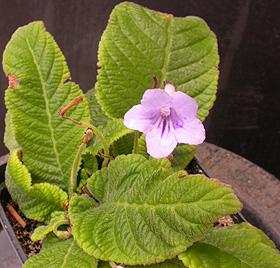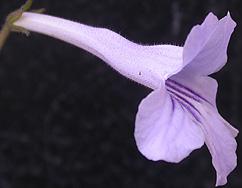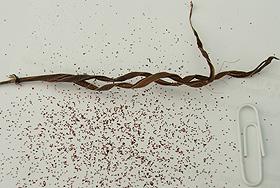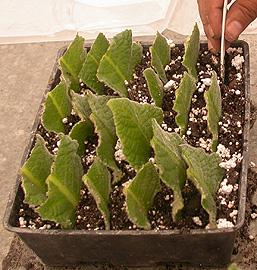Streptocarpus rexii
Streptocarpus rexii ( Bowie ex Hook.) Lindl.
Family: Gesneriaceae
Common names: wild gloxinia, twin sisters
Introduction
Streptocarpus rexii is a neat, compact perennial herb with attractive white to blue/pale violet flowers, and makes a perfect indoor or shade plant. It was the first known species in this genus and is the foundation on which modern hybrids are based.

Description
Description
Streptocarpus rexii is a medium-sized, stemless herb up to 150 mm tall, with a slender horizontal rhizome and a rosette of velvety, blunt-tipped, strap-shaped leaves that grow up to 300 mm long. Each leaf grows from the base of the plant, and is an individual plant with its own roots and inflorescence (cluster of flowers).
The inflorescence forms at the base of the leaf and grows 200 mm high, usually bearing 1 or 2 flowers and rarely up to 6 flowers. The asymmetrical flowers are white or blue/pale violet, up to 75 mm wide.

The flowering period lasts from spring until autumn (October to April). The fruit is a spirally twisted capsule about 130 mm long. When the capsule ripens, it twists open along two slits that release a mass of small seeds.

Conservation Status
Status
Many Streptocarpus species are very specific in their distribution and may occur in small populations, which makes them vulnerable to disturbance and change.
Streptocarpus rexii does not have a rare, endangered or threatened status but species such as S. liliputana, S. formosus and S. kentaniesis are on the Red Data List.
Distribution and habitat
Distribution description
Streptocarpus rexii has a wide distribution range but grows only up to an altitude of 900 m. It is the only Streptocarpus species found further south, nearer to Cape Town, than any other species. It is found on the coastal hills as well as in forests and on the cliffs above the sea, from George in the Western Cape, in the Tsitsikamma National Park and along the coast of the Eastern Cape to the southernmost part of KwaZulu-Natal.
Derivation of name and historical aspects
History
In 1818 James Bowie found a stemless plant with blue flowers that was unknown to him. Hooker placed the plant in the Indian genus Didymocarpus and called it Didymocarpus rexii as it was first found on the estate of George Rex near Knysna. About 10 years later Lindley recognized that it was an independent genus and placed it in the newly defined genus Streptocarpus. At that time it was the only known species of the genus.

The name Streptocarpus is derived from the Greek word streptos meaning twisted and carpus meaning fruit, referring to the spirally twisted fruiting capsules. The species name rexii is derived from the place where it was first collected, the estate of one George Rex, near Knysna.
An illustration by William Hooker of Streptocarpus rexii was published in Curtis's Botanical Magazine in 1830 under the name Didymocarpus rexii. John Lindley published his description of S. rexii and a colour illustration by Hart & Watts in the Botanical Register in 1828, vol. 14, plate 1173. The description and both illustrations can be viewed on the Aluka website.
Streptocarpus belongs to the family Gesneriaceae which contains ± 125 species of mostly tropical and subtropical herbs. This family consists of about 130 genera and about 2900 species worldwide. Eight genera are found in Africa but only one is found in South Africa, Streptocarpus. The members of this family that are most well-known to gardeners are the African violet, Saintpaulia and gloxinia, Sinningia speciosa.
Ecology
Ecology
The species in this family are often epiphytic, meaning they grow on trees, or lithophytic, meaning they grow on rocks. The seeds are wind-dispersed.
Streptocarpus rexii also has the ability to reduce leaf size, form an abscission layer, or wilt severely during unfavourable conditions, thus reducing stress and water loss, from which they recover completely when favourable conditions return.
Uses
Use
Streptocarpus hybrids are very popular as indoor pot plants, especially in Europe and America. There is an interesting demand for growing Streptocarpus in South Africa.
Some Streptocarpus species are used in traditional Zulu medicine, where leaf infusions are drunk to ease birth pains.
Growing Streptocarpus rexii
Grow
Many Streptocarpus species make beautiful pot plants and garden plants for shady areas. Ensure that a warm spot with good light is provided indoors but no direct sunlight as the plants burn easily. Many Streptocarpus species are grown and displayed in the Conservatory, Camphor Avenue, the Dell and in pots in the Visitors' Centre at Kirstenbosch.
Streptocarpus can easily be grown from seed and remember that species are best propagated by seed but to keep a particular hybrid or colour form identical to the parent plant, it must be propagated vegetatively, by cuttings or division.
All propagation is best done in spring which is the start of the growing season — during winter most of the plants are at rest.
This resting period will cause the plants to form abscission layers. This is where the tip of the leaf turns yellow, then brown and then dies. It is a bit unattractive but will cause no permanent damage to the leaf which continues to grow from the base. It is a natural reaction of the plant to unfavourable environmental conditions such as cold or drought. The dry leaf ends can be pulled or cut off.
For seed sowing, mix a pinch of the dust-like seed with a small amount of sand to assist with spreading the seed evenly when sowing. The medium should be well-drained but not too coarse. Cover with a very thin layer of sand. Sown seed trays should be kept out of direct sunlight but should be kept warm and moist but not wet until the young seedlings appear. Germination usually takes 3 to 4 weeks; do not allow the seedlings to dry out.
Streptocarpus can be propagated from leaf cuttings ideally taken in spring and early summer. A variety of mediums can be used as long as they are well-drained. Sand, bark, palm fibre and polystyrene or vermiculite in different ratios are all suitable. At Kirstenbosch we use 40 % bark, 40 % polystyrene and 20 % sand. The medium should be watered well and treated with a suitable fungicide before using. Only select young lush green cutting material from the centre of the plant and cut it off using a clean sharp knife or blade. The base of the plant will form more plantlets than the distal end of the leaf. Larger leaves can be cut into 30 mm strips. Always take note of which way the leaf cutting should be placed into the medium before dipping into a rooting hormone.
Place the cutting into the medium but not too deep, as this will encourage rot; plantlets will form from the base of the leaf. Alternatively, cut along either side of the midrib of the leaf and treat it in the same manner; plantlets will form at each vein junction. Depending on the species, plantlets will form along the base of the cut in one to three months. When the plantlets are well established (30-50 mm), the old leaf can be teased out from the medium and the plantlets potted up, usually between 6-12 months.

The potting medium that we use at Kirstenbosch consists of the following: 1 part good compost (2 wheelbarrows), 1 part coarse sand (2 wheelbarrows, 1 part palm fibre (10 blocks = 2 wheelbarrows). Add a small amount of organic fertilizer.
Mature plants often lose their vigour after three to five years and should be replaced with younger plants.
To prevent pests and diseases and ensure good plant care, follow good growing techniques. Do not overwater as this causes stress and keeps the plants cold and damp, which encourages fungal development. Allow the soil to dry out between watering; this may make the plants wilt quite badly but they have the ability to recover quickly. Note that severe wilting can be a sign of root rot caused by overwatering.
Worms are the most troublesome pests of Streptocarpus; keep a close eye on the plants and hand collect them or spray with a suitable poison.
Remove all plant debris — this includes dead flowers and yellow leaves — as it will encourage fungal development. Also remove the inflorescence completely after flowering to keep the plant looking attractive and to encourage new flower development. In the case of fungal disease on the plant, affected leaves should be pinched off and the rest of the plant treated with a suitable fungicide.
Feeding should occur every two weeks during the active growing season using a suitable foliar feed.
Repotting of plants should commence once the roots appear at the bottom of the pot.
References
- Burtt, B.L. & Hilliard, O.M. 1971. Streptocarpus, an African plant study. University of Natal Press, Pietermaritzburg.
- Dibley, R. & Dibley, G. 1995. Streptocarpus. Cassell, London.
- Dibley, R. 2003. Streptocarpus. Dibleys Nurseries, North Wales.
- Moriarty, A. 1982. Outeniqua, Tsitsikamma and eastern Little Karoo. South African Wild Flower Guide 2. Botanical Society of South Africa, Cape Town.
- Smith, C.A. 1966. Common names of South African plants. Memoirs of the Botanical Survey of South Africa No. 35.
- Website: Aluka.org
Credits
Etienne Arendse
Kirstenbosch National Botanical Garden
December 2008
Plant Attributes:
Plant Type: Perennial
SA Distribution: Eastern Cape, KwaZulu-Natal, Northern Cape, Western Cape
Soil type:
Flowering season: Spring, Early Summer, Late Summer, Autumn
PH:
Flower colour: Blue, White, Mauve/Lilac
Aspect: Shade
Gardening skill:
Special Features:
Horticultural zones








Rate this article
Article well written and informative
Rate this plant
Is this an interesting plant?
Login to add your Comment
Back to topNot registered yet? Click here to register.